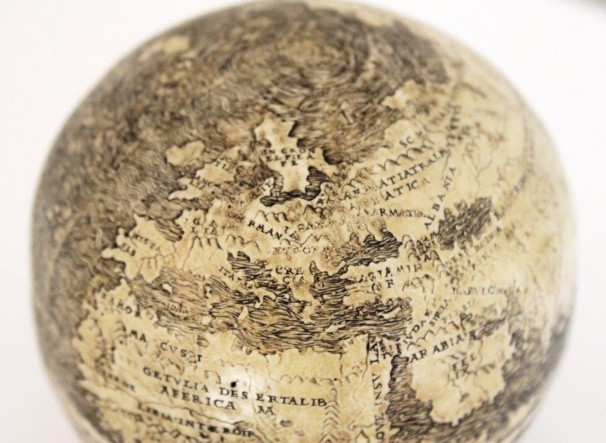It looks like you're using an Ad Blocker.
Please white-list or disable AboveTopSecret.com in your ad-blocking tool.
Thank you.
Some features of ATS will be disabled while you continue to use an ad-blocker.
6
share:
Source

This is unbelievably cool!
First what a cool object to find and date, but, to have 'Here be dragons' on it is awesome!
I know they go on to explain that it was probably a myth and they show sea monsters too, but, that's not the point!
Out of all the things to engrave onto this map dated so long ago, 'here be dragons'? Maybe there was some validity to this statement...
I hope anyways...
I just thought I would bring it here because I find this items so damn amazing.
Any thoughts?
Pred...

An Austrian collector has found what may be the oldest globe, dated 1504, to depict the New World, engraved with immaculate detail on two conjoined halves of ostrich eggs.
The globe, about the size of a grapefruit, is labeled in Latin and includes what were considered exotic territories such as Japan, Brazil and Arabia. North America is depicted as a group of scattered islands. The globe’s lone sentence, above the coast of Southeast Asia, is “Hic Sunt Dracones.”
The detailed globe, dated 1504, is engraved on two conjoined halves of ostrich eggs and warns of dragons.
Ads by CouponDropDown
“ ‘Here be dragons,’ a very interesting sentence,” said Thomas Sander, editor of the Portolan, the journal of the Washington Map Society. The journal published a comprehensive analysis of the globe Monday by collector Stefaan Missinne. “In early maps, you would see images of sea monsters; it was a way to say there’s bad stuff out there.”
This is unbelievably cool!
First what a cool object to find and date, but, to have 'Here be dragons' on it is awesome!
I know they go on to explain that it was probably a myth and they show sea monsters too, but, that's not the point!
Out of all the things to engrave onto this map dated so long ago, 'here be dragons'? Maybe there was some validity to this statement...
I hope anyways...
I just thought I would bring it here because I find this items so damn amazing.
Any thoughts?
Pred...
edit on 21-8-2013 by predator0187 because: (no reason given)
edit on 21-8-2013 by predator0187 because: (no reason
given)
Here be dragons....awesome.
Thats a damn cool find, think i will research it a bit.
Lenox Globe
Here Be Dragons...Everywhere
So from what i can tell this would be the third? time that such a phrase has appeared.
It should be noted that maps of America were made around 1507 but this is still cool..
Amerigo
Thats a damn cool find, think i will research it a bit.
The only other map or globe on which this specific phrase appears is what can arguably be called the egg’s twin: the copper Hunt-Lenox Globe, dated around 1510 and housed by the Rare Book Division of the New York Public Library. Before the egg, the copper globe had been the oldest one known to show the New World. The two contain remarkable similarities.
Lenox Globe
Here Be Dragons...Everywhere
That English mapmakers formerly placed the phrase "here be dragons" at the edges of their known world has somehow become general knowledge... and here is the list of all known historical maps upon which these words appear:
In other words, there aren't any. Of course, it is not surprising that the English phrase does not appear on maps from a time and place where Latin was the language of learning, so here is the list of all known historical maps where the phrase appears in Latin:
edit on 21-8-2013 by
Thorneblood because: (no reason given)
So from what i can tell this would be the third? time that such a phrase has appeared.
It should be noted that maps of America were made around 1507 but this is still cool..
Amerigo
The expeditions became widely known in Europe after two accounts attributed to Vespucci were published between 1502 and 1504. In 1507, Martin Waldseemüller produced a world map on which he named the new continent America after Vespucci's first name, Amerigo. In an accompanying book, Waldseemüller published one of the Vespucci accounts, which led to criticism that Vespucci was trying to upset Christopher Columbus' glory. However, the rediscovery in the 18th century of other letters by Vespucci, primarily the Soderini Letter, has led to the view that the early published accounts could be fabrications, not by Vespucci, but by others.
edit on 21-8-2013 by Thorneblood because: (no reason given)
I do not remember the title of the thread, but there was one I read recently that said Marco Polo wrote about dragons being raised and used, like we
do bovines, for all kind of jobs, in China.
He said that less than 200 years before that globe was made.
And it is a really cool find. Can you believe it has survived for so long, being only an egg shell? I know its a tough shell, but still!
He said that less than 200 years before that globe was made.
And it is a really cool find. Can you believe it has survived for so long, being only an egg shell? I know its a tough shell, but still!
the dragons reference could be about the komodos in that region?
maybe word of mouth spread in that time period of them somehow who knows
maybe word of mouth spread in that time period of them somehow who knows
reply to post by NowanKenubi
Most people seem to think that Marco was referring to crocodiles.....hard to say tho...
I will dig thru a few threads but i did find this which was interesting at least...
Dinosaurs
Dino's is what i usually think of when people say Dragons....but

See the dragon?
Most people seem to think that Marco was referring to crocodiles.....hard to say tho...
I will dig thru a few threads but i did find this which was interesting at least...
Dinosaurs
The Madagascarians related to him that "at a certain season of the year...the Rukh makes its appearance from the south. Persons who have seen this bird assert that when the wings are spread, they span fifty feet." [Approximately the same size as Native American accounts in The Legend of the Giant Bird]. Polo tells how he heard of a mighty feather presented to the Grand Khan of China purportedly taken from a Rukh and measuring ninety "spans" long. In classic literature a "span" is usually described as being the distance between the tip of the thumb and the tip of the little finger in a spread out hand, roughly nine inches. If the translation "ninety" is taken to be accurate that would make the feather over sixty-seven feet in length, which is not likely. It is probably a mistranslation with the actual measure being NINE spans. That would make the feather somewhere just over six feet long, similar in length to the one described as coming from the American southwest in The Boy and the Giant Feather
Dino's is what i usually think of when people say Dragons....but

See the dragon?
edit on 21-8-2013 by Thorneblood because: (no reason given)
reply to post by Thorneblood
Thanks for that bit of info. That was wholly different from what I had read about Polo!
Where did that photo you showed came from? lol Yes, I did see the flying dragon there!
___
It would have been nice to have more pics of the globe. I wonder if the maker had signed near the equator, where the glue messed things written there?
Thanks for that bit of info. That was wholly different from what I had read about Polo!
Where did that photo you showed came from? lol Yes, I did see the flying dragon there!
___
It would have been nice to have more pics of the globe. I wonder if the maker had signed near the equator, where the glue messed things written there?
reply to post by NowanKenubi
It was one of a series of pictures from the Idylwild fire in California....
Weird right? I mean i get Pareidolia and all but still you can even see the fire its breathing....and the last name of the guy who took the pic is Drake.....Coincidence?
Thread
It was one of a series of pictures from the Idylwild fire in California....
Weird right? I mean i get Pareidolia and all but still you can even see the fire its breathing....and the last name of the guy who took the pic is Drake.....Coincidence?
Thread
Originally posted by Thorneblood
reply to post by NowanKenubi
Most people seem to think that Marco was referring to crocodiles.....hard to say tho...
I will dig thru a few threads but i did find this which was interesting at least...
Dinosaurs
The Madagascarians related to him that "at a certain season of the year...the Rukh makes its appearance from the south. Persons who have seen this bird assert that when the wings are spread, they span fifty feet." [Approximately the same size as Native American accounts in The Legend of the Giant Bird]. Polo tells how he heard of a mighty feather presented to the Grand Khan of China purportedly taken from a Rukh and measuring ninety "spans" long. In classic literature a "span" is usually described as being the distance between the tip of the thumb and the tip of the little finger in a spread out hand, roughly nine inches. If the translation "ninety" is taken to be accurate that would make the feather over sixty-seven feet in length, which is not likely. It is probably a mistranslation with the actual measure being NINE spans. That would make the feather somewhere just over six feet long, similar in length to the one described as coming from the American southwest in The Boy and the Giant Feather
Dino's is what i usually think of when people say Dragons....but
See the dragon?edit on 21-8-2013 by Thorneblood because: (no reason given)
my new desktop...thanks Thorn
new topics
-
An Interesting Conversation with ChatGPT
Science & Technology: 4 hours ago
top topics
-
Have you noticed?? Post Election news coverage...
World War Three: 17 hours ago, 12 flags -
Squirrels becoming predators
Fragile Earth: 16 hours ago, 10 flags -
Drone Shooting Arrest - Walmart Involved
Mainstream News: 15 hours ago, 10 flags -
World's Best Christmas Lights!
General Chit Chat: 15 hours ago, 8 flags -
Can someone 'splain me like I'm 5. Blockchain?
Science & Technology: 16 hours ago, 7 flags -
Labour's Anti-Corruption Minister Named in Bangladesh Corruption Court Papers
Regional Politics: 17 hours ago, 6 flags -
An Interesting Conversation with ChatGPT
Science & Technology: 4 hours ago, 3 flags
active topics
-
The Truth Behind the Manchester Airport "Police Assault" Video
Social Issues and Civil Unrest • 43 • : gortex -
An Interesting Conversation with ChatGPT
Science & Technology • 11 • : randomuser2034 -
World's Best Christmas Lights!
General Chit Chat • 13 • : Naftalin -
Smartest Man in the World Tells His Theory About What Happens At Death
Philosophy and Metaphysics • 46 • : Naftalin -
Have you noticed?? Post Election news coverage...
World War Three • 9 • : ElitePlebeian2 -
The King James Bible, it's Translation, it's Preservation and its Inspiration
Religion, Faith, And Theology • 44 • : GENERAL EYES -
Drones everywhere in New Jersey ---and Elsewhere Master Thread
Aliens and UFOs • 201 • : worldstarcountry -
Drone Shooting Arrest - Walmart Involved
Mainstream News • 26 • : worldstarcountry -
Can someone 'splain me like I'm 5. Blockchain?
Science & Technology • 74 • : worldstarcountry -
Trump Meets Kristen Welker on Meet the Press
Mainstream News • 20 • : Astrocometus
6
